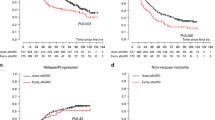Abstract
Forty-two patients allografted for multiple myeloma after not having attained at least a partial remission (n = 19) or after having experienced disease progression (n = 23) following one autograft were compared with 42 pair-matched controls who underwent salvage autotransplantation under identical conditions. Autografted controls were matched closely for albumin, C-reactive protein, creatinine, disease sensitivity, duration of standard therapy prior to the first transplant, Ig isotype, karyotype, LDH, and response to the first transplant, but, in comparison to allografted patients, were older, had higher β2-microglobulin, and had a shorter interval between the two transplants. The complete remission rate was 41% after allogeneic and 33% after autologous transplantation (P = NS). The 3-year probability of event-free survival was comparable for the two groups (25 ± 8% after autografting and 20 ± 8% after allografting). The 3-year probability of survival was significantly higher after autologous transplantation (54 ± 8% vs 29 ± 9%; P = 0.01). Twenty-one patients in the autograft group were alive 11–59 months (median 32) following the second transplant, while 15 patients in the allograft group were alive at 10–53 months (median 20). The 3-year probability of disease progression was significantly lower after allogeneic transplantation (31 ± 10% vs 72 ± 9%, P = 0.03). The 1-year probability of transplant-related mortality was significantly higher after allografting (43 ± 8% vs 10 ± 5%; P = 0.0001). We conclude that while autografting appears to be superior to allografting for salvage therapy of myeloma persisting or relapsing after one previous autotransplant in terms of overall survival, event-free survival is comparable due to significantly lower disease progression after allografting. Reduction in allograft-related toxicity can potentially improve the results of allogeneic transplantation significantly.
Similar content being viewed by others
Author information
Authors and Affiliations
Rights and permissions
About this article
Cite this article
Mehta, J., Tricot, G., Jagannath, S. et al. Salvage autologous or allogeneic transplantation for multiple myeloma refractory to or relapsing after a first-line autograft?. Bone Marrow Transplant 21, 887–892 (1998). https://doi.org/10.1038/sj.bmt.1701208
Received:
Accepted:
Published:
Issue Date:
DOI: https://doi.org/10.1038/sj.bmt.1701208
- Springer Nature Limited
Keywords
This article is cited by
-
Autologous hematopoietic cell transplantation for relapsed multiple myeloma performed with cells procured after previous transplantation–study on behalf of CMWP of the EBMT
Bone Marrow Transplantation (2022)
-
Utilization of hematopoietic stem cell transplantation for the treatment of multiple myeloma: a Mayo Stratification of Myeloma and Risk-Adapted Therapy (mSMART) consensus statement
Bone Marrow Transplantation (2019)
-
Evolving paradigms in the treatment of relapsed/refractory multiple myeloma: increased options and increased complexity
Bone Marrow Transplantation (2016)
-
Allogeneic stem cell transplantation for multiple myeloma: is there a future?
Bone Marrow Transplantation (2016)
-
Stem cell mobilization in heavily pretreated multiple myeloma patients with prior high dose melphalan and auto-SCT
Bone Marrow Transplantation (2013)




